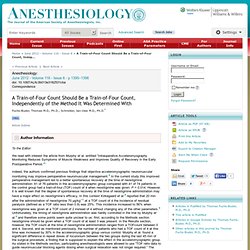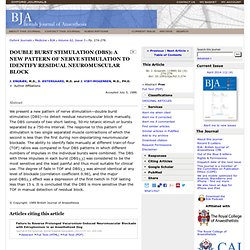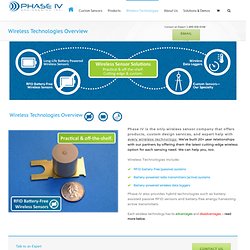

Www.sparkfun.com/datasheets/Sensors/Flex/FLEXSENSOR(REVA1).pdf. Flex Sensor 4.5" A Train-of-Four Count Should Be a Train-of-Four Count, Indep... : Anesthesiology. Anesthesiology: doi: 10.1097/ALN.0b013e3182531cba Correspondence Author Information *Maastricht University Medical Center, Maastricht, The Netherlands. j.schreiber@mumc.nl Accepted for publication February 21, 2012.

To the Editor: We read with interest the article from Murphy et al. entitled “Intraoperative Acceleromyography Monitoring Reduces Symptoms of Muscle Weakness and Improves Quality of Recovery in the Early Postoperative Period.”1 Indeed, the authors confirmed previous findings that objective acceleromyographic neuromuscular monitoring may improve perioperative neuromuscular management.2 In the current study this improved perioperative management led to a better spontaneous recovery at the time of neostigmine administration: 61 of 76 patients in the acceleromyographic group compared with 41 of 74 patients in the control group had a train-of-four (TOF) count of 4 when neostigmine was given: P = 0.014. References. Www.xavant.com/downloads/NMS450sellsheet.pdf.
Mems-based accelerometers to measure twitch in thumb. Indian Journal of Anaesthesia (IJA)- Detection of residual neuromuscular blockade after use of non-depolarizing muscle relaxant : Utility of double burst stimulation comparing with train-of-four : Download PDF. Download PDF Detection of residual neuromuscular blockade after use of non-depolarizing muscle relaxant : Utility of double burst stimulation comparing with train-of-four This is a temporary file and hence do not link it from a website, instead link the URL of this page if you wish to link the PDF file.To read this article you will require Adobe© Acrobat Reader, if you do not have this installed you can download it from here.

Neuromuscular monitoring by intensive care nurses: comparison of acceleromyography and tactile assessment. DOUBLE BURST STIMULATION (DBS): A NEW PATTERN OF NERVE STIMULATION TO IDENTIFY RESIDUAL NEUROMUSCULAR BLOCK. + Author Affiliations Accepted July 5, 1988.

We present a new pattern of nerve stimulation—double burst stimulation (DBS)—to detect residual neuromuscular block manually. The DBS consists of two short lasting, 50-Hz tetanic stimuli or bursts separated by a 750-ms interval. The response to this pattern of stimulation is two single separated muscle contractions of which the second is less than the first during non-depolarizing neuromuscular blockade. Journal of Anesthesia, Volume 3, Number 1. Automatic monitoring of patient relaxation status. The Strain Gage. When external forces are applied to a stationary object, stress and strain are the result.

Stress is defined as the object's internal resisting forces, and strain is defined as the displacement and deformation that occur. For a uniform distribution of internal resisting forces, stress can be calculated (Figure 2-1) by dividing the force (F) applied by the unit area (A): Strain is defined as the amount of deformation per unit length of an object when a load is applied. Strain is calculated by dividing the total deformation of the original length by the original length (L): Typical values for strain are less than 0.005 inch/inch and are often expressed in micro-strain units: Strain may be compressive or tensile and is typically measured by strain gages. Fundamentally, all strain gages are designed to convert mechanical motion into an electronic signal.
The ideal strain gage would change resistance only due to the deformations of the surface to which the sensor is attached. Wireless Sensors Overview. Phase IV is the only wireless sensor company that offers products, custom design services, and expert help with every wireless technology.

We’ve built 20+ year relationships with our partners by offering them the latest cutting-edge wireless option for each sensing need. We can help you, too. Wireless Technologies Include: Phase IV also provides hybrid technologies such as battery-assisted passive RFID sensors and battery-free energy-harvesting active transmitters. Each wireless technology has its advantages and disadvantages – read more below. Contact Us Talk to an Expert Questions about Phase IV Engineering's RFID & wireless sensor technology? RFID Battery-Free (Passive) Wireless Technology – Advantages & Disadvantages Advantages of Battery-Free RFID Sensors Ultra Long Life - no battery to ever change. Ideal to be embedded inside walls, carbon fiber panels, rubber, pavement… because they never need to be maintained.
Ultra Small. Resenv.media.mit.edu/classes/MAS836/Readings/MSI-techman.pdf.
Pattern of Pulses That Maximize Force Output From Single Human Thenar Motor Units. Abstract We assessed the sequence of nerve impulses that maximize force output from individual human thenar motor units.

When these motor units were stimulated intraneurally by a variable sequence of seven pulses, the pattern of pulses that elicited maximum force always started with a short (5–15 ms) interpulse interval termed a “doublet.” The twitch force summation caused by this “doublet” elicited, on average, 48 ± 13% (SD) of the maximum tetanic force. The peak amplitude of “doublet” forces was 3.5 times that of the initial twitches, and twitch potentiation appeared to have little influence on twitch force summation elicited by the “doublets.” For some units, the second optimal interpulse interval was also short. Subjects and experimental setup Four men and three women with no history of any neurological disorder were chosen as research subjects.
The experimental setup shown in Fig.1A has been described previously (Westling et al. 1990). Comparison of contractile properties of single motor units in human intrinsic and extrinsic finger muscles. Twitcher - 1998.pdf (application/pdf Object)